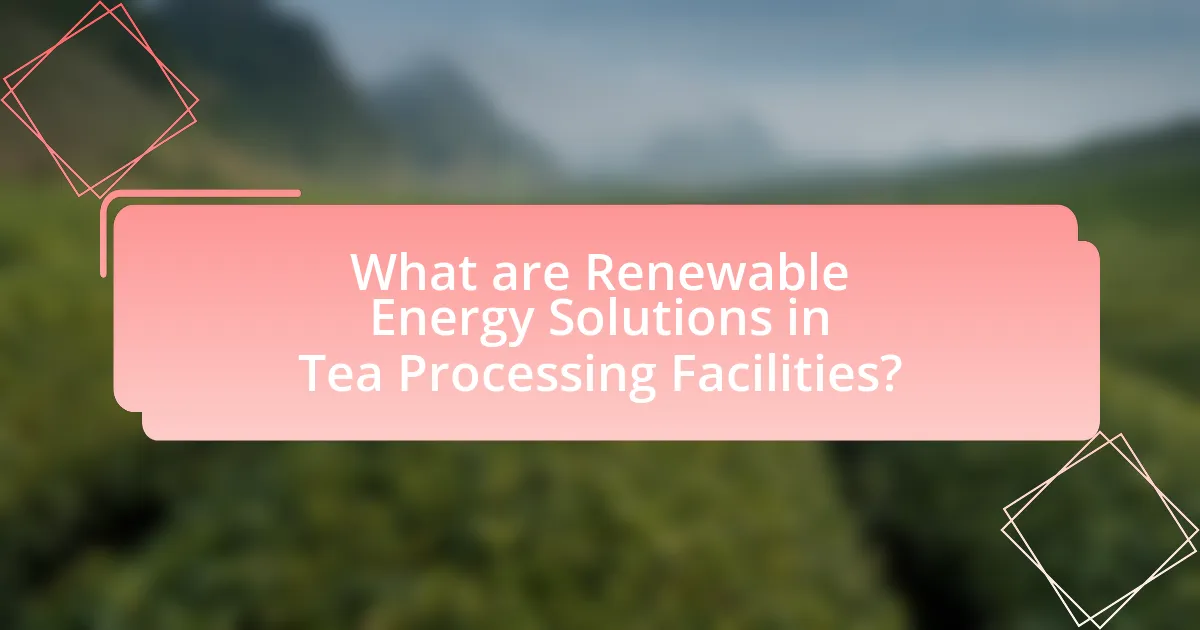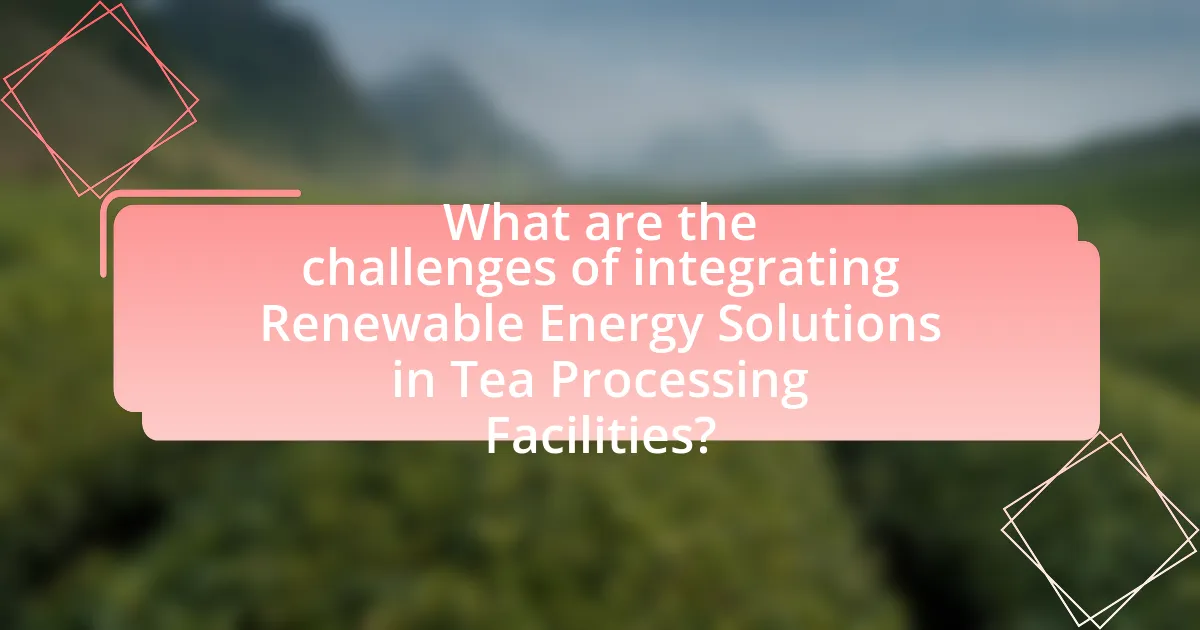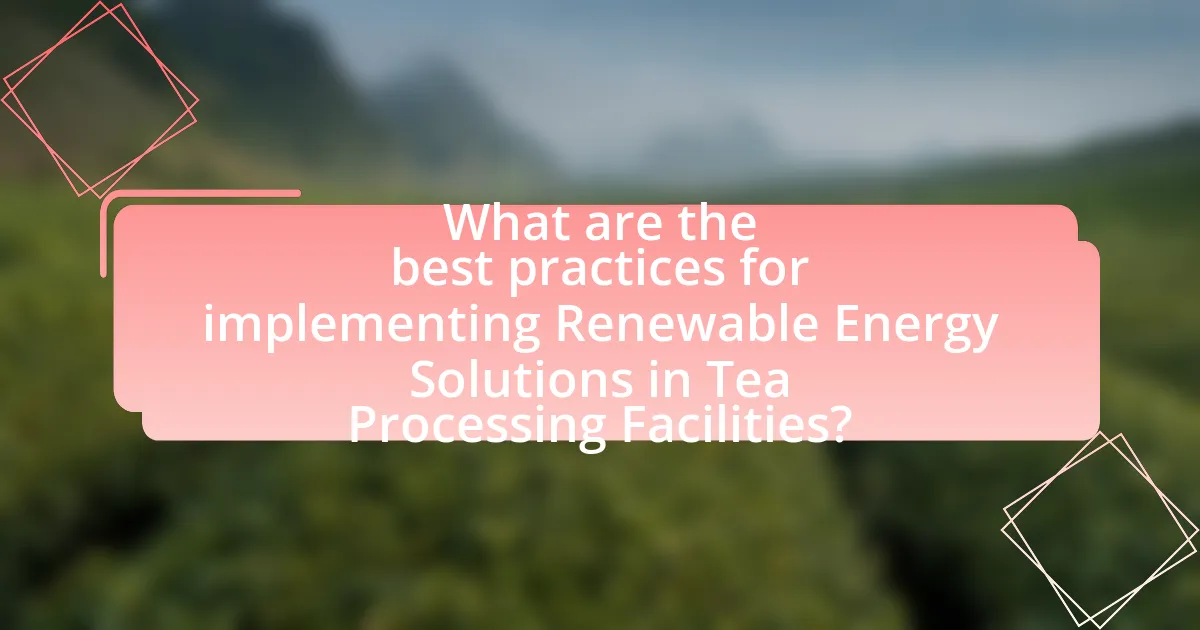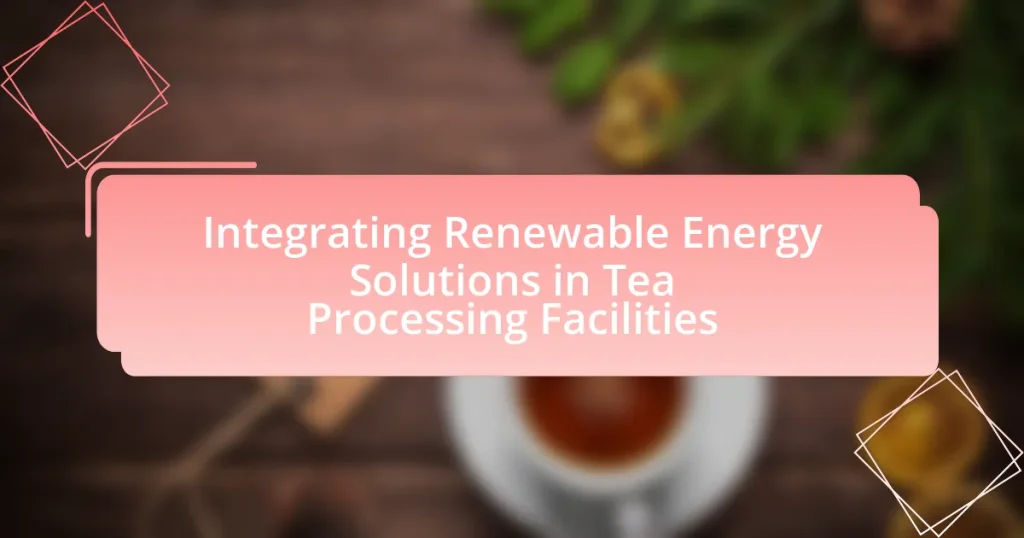The article focuses on integrating renewable energy solutions in tea processing facilities, highlighting the use of solar, biomass, and wind energy. It discusses the impact of these solutions on operational efficiency, cost reduction, and environmental sustainability, emphasizing the importance of reducing carbon emissions in the energy-intensive tea industry. Key considerations include assessing energy needs, selecting appropriate technologies, overcoming technical challenges, and securing funding for renewable projects. The article also outlines best practices for implementation, ongoing maintenance, and performance monitoring to ensure successful integration of renewable energy systems.

What are Renewable Energy Solutions in Tea Processing Facilities?
Renewable energy solutions in tea processing facilities include solar energy, biomass energy, and wind energy. Solar energy can be harnessed through photovoltaic panels to power machinery and lighting, significantly reducing reliance on fossil fuels. Biomass energy utilizes waste materials from tea production, such as leaves and stems, to generate heat or electricity, promoting sustainability and waste reduction. Wind energy can also be employed where feasible, providing an additional renewable source for energy needs. These solutions not only lower operational costs but also contribute to a reduced carbon footprint, aligning with global sustainability goals.
How do renewable energy solutions impact tea processing operations?
Renewable energy solutions significantly enhance tea processing operations by reducing energy costs and minimizing environmental impact. The integration of solar panels or biomass systems can provide a sustainable energy source, leading to lower operational expenses and improved energy efficiency. For instance, a study by the International Renewable Energy Agency (IRENA) found that using solar energy in agricultural processing can reduce energy costs by up to 30%. Additionally, renewable energy sources contribute to a decrease in greenhouse gas emissions, aligning tea processing with global sustainability goals. This shift not only supports the environment but also meets the increasing consumer demand for sustainably produced goods.
What types of renewable energy sources are applicable in tea processing?
The types of renewable energy sources applicable in tea processing include solar energy, biomass energy, and hydroelectric energy. Solar energy can be harnessed through photovoltaic panels to power equipment and facilities, while biomass energy utilizes organic materials, such as tea waste, for energy production through combustion or anaerobic digestion. Hydroelectric energy can be generated from nearby water sources to provide electricity for processing operations. These renewable sources not only reduce reliance on fossil fuels but also contribute to sustainable practices in the tea industry.
How do these energy sources integrate with existing processing systems?
Renewable energy sources, such as solar and biomass, integrate with existing processing systems in tea facilities by providing alternative power for operations while reducing reliance on fossil fuels. For instance, solar panels can be installed on facility rooftops to generate electricity, which can directly power machinery and lighting, thereby decreasing operational costs and carbon emissions. Biomass, derived from tea waste, can be converted into bioenergy through anaerobic digestion or combustion, supplying heat and electricity for processing activities. This integration not only enhances energy efficiency but also aligns with sustainability goals, as evidenced by a study from the International Renewable Energy Agency, which highlights that renewable energy adoption in agricultural sectors can lead to a 30% reduction in energy costs.
Why is it important to integrate renewable energy in tea processing?
Integrating renewable energy in tea processing is crucial for reducing carbon emissions and enhancing sustainability. The tea processing industry is energy-intensive, often relying on fossil fuels, which contribute significantly to greenhouse gas emissions. By adopting renewable energy sources such as solar, wind, or biomass, tea processing facilities can lower their carbon footprint, promote environmental stewardship, and align with global sustainability goals. For instance, a study by the International Renewable Energy Agency (IRENA) indicates that transitioning to renewable energy can reduce emissions by up to 70% in energy-intensive sectors. This shift not only benefits the environment but also improves energy security and can lead to cost savings in the long term.
What environmental benefits arise from using renewable energy in tea processing?
Using renewable energy in tea processing significantly reduces greenhouse gas emissions. This transition from fossil fuels to renewable sources, such as solar or wind energy, minimizes carbon footprints associated with energy consumption in processing facilities. For instance, a study by the International Renewable Energy Agency indicates that renewable energy can cut emissions by up to 70% in industrial applications. Additionally, renewable energy sources often require less water compared to conventional energy production, further conserving vital resources in tea-growing regions. This shift not only supports environmental sustainability but also enhances the overall ecological balance by reducing air and water pollution associated with traditional energy sources.
How does renewable energy integration affect operational costs?
Renewable energy integration reduces operational costs by decreasing reliance on fossil fuels and lowering energy expenses. For instance, facilities that utilize solar or wind energy can significantly cut their electricity bills, as these sources often have lower marginal costs compared to traditional energy sources. A study by the International Renewable Energy Agency (IRENA) found that renewable energy can lead to savings of up to 30% in operational costs for industrial sectors, including food processing. Additionally, integrating renewable energy can enhance energy efficiency, further contributing to cost reductions through improved operational practices and reduced energy waste.

What are the challenges of integrating Renewable Energy Solutions in Tea Processing Facilities?
Integrating renewable energy solutions in tea processing facilities faces several challenges, primarily related to high initial investment costs, technological compatibility, and operational disruptions. High initial investment costs can deter facilities from adopting renewable technologies, as the upfront capital required for solar panels, wind turbines, or biomass systems can be substantial. Technological compatibility issues arise when existing processing equipment is not designed to work with renewable energy sources, necessitating additional modifications or replacements. Operational disruptions may occur during the transition phase, affecting production schedules and efficiency. These challenges are supported by industry reports indicating that while renewable energy can reduce long-term operational costs, the barriers to entry remain significant for many tea processing facilities.
What technical barriers exist in the adoption of renewable energy?
Technical barriers in the adoption of renewable energy include issues such as energy storage limitations, grid integration challenges, and high initial costs of technology. Energy storage limitations hinder the ability to store excess energy generated from renewable sources, making it difficult to ensure a consistent energy supply. Grid integration challenges arise from the need to adapt existing infrastructure to accommodate variable energy sources like solar and wind, which can lead to instability in energy distribution. High initial costs of renewable energy technologies, such as solar panels and wind turbines, can deter investment despite long-term savings. According to the International Renewable Energy Agency, the upfront costs for solar photovoltaic systems can be significant, impacting widespread adoption.
How can tea processing facilities overcome these technical challenges?
Tea processing facilities can overcome technical challenges by adopting advanced renewable energy technologies, such as solar panels and biomass systems, to enhance energy efficiency and reduce operational costs. Implementing solar energy can provide a sustainable power source, significantly lowering reliance on fossil fuels, while biomass systems can utilize waste materials from tea production, creating a closed-loop system that minimizes waste and maximizes energy use. For instance, a study by the International Renewable Energy Agency highlights that integrating solar energy in agricultural processing can reduce energy costs by up to 30%, demonstrating the financial viability of such solutions.
What role does staff training play in successful integration?
Staff training is crucial for successful integration of renewable energy solutions in tea processing facilities. It equips employees with the necessary skills and knowledge to operate new technologies effectively, ensuring that systems are utilized to their full potential. For instance, a study by the International Renewable Energy Agency highlights that organizations with comprehensive training programs experience a 30% increase in operational efficiency when adopting renewable technologies. This training also fosters a culture of safety and compliance, reducing the risk of accidents and enhancing overall productivity.
What financial considerations should be taken into account?
When integrating renewable energy solutions in tea processing facilities, key financial considerations include initial investment costs, operational savings, and potential government incentives. Initial investment costs encompass the purchase and installation of renewable energy systems, such as solar panels or biomass boilers, which can range from tens of thousands to millions of dollars depending on the scale of the facility. Operational savings arise from reduced energy bills and lower maintenance costs over time, with studies indicating that renewable energy can decrease energy expenses by 20-50%. Additionally, government incentives, such as tax credits or grants, can significantly offset initial costs, making renewable energy more financially viable. For instance, the U.S. federal solar tax credit allows for a 26% deduction on installation costs, enhancing the financial attractiveness of renewable energy investments.
How can tea processing facilities secure funding for renewable energy projects?
Tea processing facilities can secure funding for renewable energy projects by applying for government grants, engaging with private investors, and participating in green financing initiatives. Government programs often provide financial support specifically aimed at promoting renewable energy adoption in agricultural sectors, including tea processing. For instance, the U.S. Department of Agriculture offers grants for renewable energy projects through its Rural Energy for America Program, which can be leveraged by tea facilities. Additionally, private investors are increasingly interested in sustainable projects, and facilities can attract funding by presenting a solid business case that highlights potential energy savings and environmental benefits. Furthermore, green financing options, such as green bonds or loans from financial institutions focused on sustainability, can provide necessary capital for these projects.
What are the potential return on investment (ROI) metrics for renewable energy solutions?
The potential return on investment (ROI) metrics for renewable energy solutions include energy cost savings, payback period, net present value (NPV), internal rate of return (IRR), and carbon offset value. Energy cost savings quantify the reduction in utility bills resulting from renewable energy adoption, while the payback period measures the time required to recoup the initial investment through these savings. NPV calculates the difference between the present value of cash inflows and outflows over time, providing insight into the profitability of the investment. IRR represents the annualized rate of return expected from the investment, helping to compare it against other investment opportunities. Lastly, carbon offset value accounts for the financial benefits associated with reducing greenhouse gas emissions, which can be monetized through carbon credits. These metrics collectively provide a comprehensive assessment of the financial viability and benefits of integrating renewable energy solutions in tea processing facilities.

What are the best practices for implementing Renewable Energy Solutions in Tea Processing Facilities?
The best practices for implementing renewable energy solutions in tea processing facilities include conducting a comprehensive energy audit, selecting appropriate renewable technologies, and ensuring stakeholder engagement. Conducting an energy audit helps identify energy consumption patterns and potential areas for improvement, which is essential for optimizing energy use. Selecting technologies such as solar panels, biomass boilers, or wind turbines should be based on local resource availability and facility needs, as these technologies can significantly reduce reliance on fossil fuels. Engaging stakeholders, including employees and local communities, fosters support and collaboration, which is crucial for successful implementation. These practices are supported by case studies showing that facilities adopting renewable energy solutions have achieved up to 30% reductions in energy costs and improved sustainability metrics.
How can facilities assess their energy needs before integration?
Facilities can assess their energy needs before integration by conducting a comprehensive energy audit. This audit involves analyzing current energy consumption patterns, identifying peak usage times, and evaluating the efficiency of existing systems. According to the U.S. Department of Energy, energy audits can reveal opportunities for energy savings and help facilities understand their baseline energy requirements, which is crucial for determining the capacity needed for renewable energy solutions. By utilizing tools such as energy modeling software and monitoring equipment, facilities can gather precise data on their energy usage, enabling informed decisions regarding the integration of renewable energy sources.
What tools and methodologies are available for energy assessment?
Energy assessment tools and methodologies include energy audits, simulation software, and benchmarking techniques. Energy audits systematically evaluate energy consumption and identify efficiency opportunities, while simulation software, such as EnergyPlus and RETScreen, models energy use and renewable energy integration. Benchmarking techniques compare energy performance against industry standards or similar facilities, providing insights into potential improvements. These methodologies are essential for optimizing energy use in tea processing facilities, ensuring effective integration of renewable energy solutions.
How can facilities prioritize renewable energy projects based on their assessments?
Facilities can prioritize renewable energy projects by conducting comprehensive assessments that evaluate potential energy savings, cost-effectiveness, and environmental impact. These assessments should include a detailed analysis of current energy consumption patterns, available renewable resources, and the financial implications of various renewable technologies. For instance, a facility may find that solar energy systems provide the highest return on investment compared to wind or biomass options, based on local sunlight availability and installation costs. Additionally, prioritization can be informed by regulatory incentives and sustainability goals, which can enhance the feasibility of specific projects. By systematically analyzing these factors, facilities can make informed decisions that align with both operational efficiency and sustainability objectives.
What are the key steps in the implementation process?
The key steps in the implementation process of integrating renewable energy solutions in tea processing facilities include assessing energy needs, selecting appropriate renewable technologies, designing the system, securing financing, installing the system, and monitoring performance.
First, assessing energy needs involves evaluating current energy consumption and identifying areas for improvement. Next, selecting appropriate renewable technologies, such as solar panels or biomass systems, is crucial to meet the specific energy requirements of the facility. Designing the system ensures that the chosen technologies are effectively integrated into existing operations. Securing financing is essential to cover the costs of installation and operation, often involving grants or loans. The installation step involves physically setting up the renewable energy systems, followed by monitoring performance to ensure efficiency and effectiveness over time.
These steps are validated by industry practices that emphasize a structured approach to energy transition, ensuring that facilities can sustainably meet their energy demands while reducing carbon footprints.
How should facilities approach the selection of renewable energy technologies?
Facilities should approach the selection of renewable energy technologies by conducting a comprehensive assessment of their energy needs, available resources, and environmental impact. This involves evaluating the specific energy consumption patterns of tea processing operations, identifying local renewable resources such as solar, wind, or biomass, and analyzing the feasibility and cost-effectiveness of each technology. For instance, a study by the International Renewable Energy Agency (IRENA) indicates that solar energy can reduce operational costs by up to 30% in agricultural facilities. By prioritizing technologies that align with their operational goals and sustainability targets, facilities can optimize energy efficiency and reduce their carbon footprint.
What project management strategies can ensure successful implementation?
Effective project management strategies for ensuring successful implementation include clear goal setting, stakeholder engagement, and risk management. Clear goal setting aligns the project team with specific, measurable objectives, which is crucial for tracking progress and ensuring accountability. Stakeholder engagement fosters collaboration and communication among all parties involved, which enhances support and minimizes resistance to change. Risk management involves identifying potential challenges early and developing mitigation strategies, which helps to prevent delays and budget overruns. Research indicates that projects with defined goals and active stakeholder involvement are 30% more likely to succeed, demonstrating the importance of these strategies in achieving successful outcomes in complex projects like integrating renewable energy solutions in tea processing facilities.
What ongoing maintenance practices are essential for renewable energy systems?
Ongoing maintenance practices essential for renewable energy systems include regular inspections, performance monitoring, and timely repairs. Regular inspections help identify wear and tear on components such as solar panels, wind turbines, and batteries, ensuring they operate efficiently. Performance monitoring involves tracking energy output and system efficiency, allowing for the detection of anomalies that may indicate maintenance needs. Timely repairs are crucial to prevent minor issues from escalating into major failures, which can lead to costly downtime. According to the National Renewable Energy Laboratory, routine maintenance can enhance the lifespan of renewable energy systems by up to 25%, demonstrating the importance of these practices in maintaining operational efficiency.
How can facilities monitor the performance of renewable energy systems effectively?
Facilities can effectively monitor the performance of renewable energy systems by utilizing advanced monitoring technologies such as real-time data analytics, IoT sensors, and performance management software. These technologies enable continuous tracking of energy production, consumption, and system efficiency, allowing for immediate identification of issues and optimization of operations. For instance, a study by the National Renewable Energy Laboratory found that integrating IoT sensors can improve system performance monitoring by up to 30%, leading to enhanced energy management and reduced operational costs.
What common issues should facilities be prepared to troubleshoot?
Facilities should be prepared to troubleshoot issues related to energy supply interruptions, equipment malfunctions, and system integration challenges when integrating renewable energy solutions in tea processing. Energy supply interruptions can occur due to fluctuations in renewable energy sources, such as solar or wind, which may not provide consistent power. Equipment malfunctions can arise from the integration of new technologies, leading to inefficiencies or breakdowns in processing machinery. Additionally, system integration challenges may involve compatibility issues between existing infrastructure and new renewable energy systems, requiring careful planning and technical expertise to resolve. These issues are critical as they can directly impact production efficiency and operational costs in tea processing facilities.


